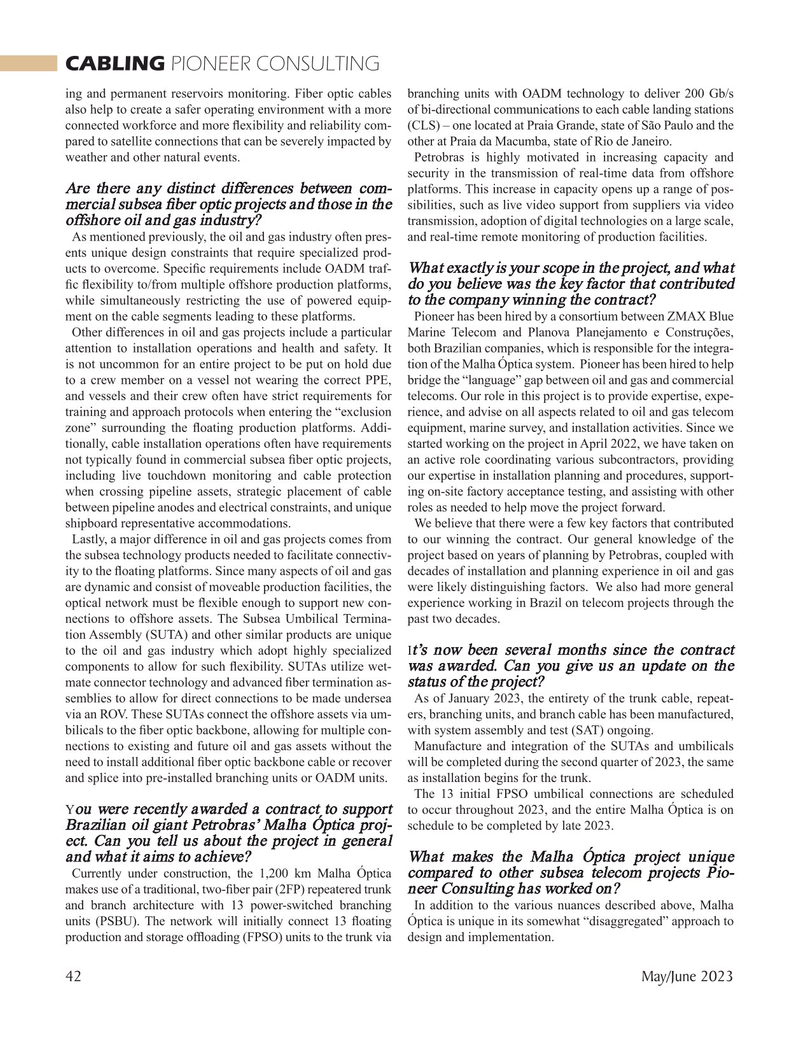
Page 42: of Marine Technology Magazine (May 2023)
Read this page in Pdf, Flash or Html5 edition of May 2023 Marine Technology Magazine
CABLING PIONEER CONSULTING ing and permanent reservoirs monitoring. Fiber optic cables branching units with OADM technology to deliver 200 Gb/s also help to create a safer operating environment with a more of bi-directional communications to each cable landing stations connected workforce and more ? exibility and reliability com- (CLS) – one located at Praia Grande, state of São Paulo and the pared to satellite connections that can be severely impacted by other at Praia da Macumba, state of Rio de Janeiro. weather and other natural events. Petrobras is highly motivated in increasing capacity and security in the transmission of real-time data from offshore
Are there any distinct differences between com- platforms. This increase in capacity opens up a range of pos- mercial subsea ? ber optic projects and those in the sibilities, such as live video support from suppliers via video offshore oil and gas industry? transmission, adoption of digital technologies on a large scale,
As mentioned previously, the oil and gas industry often pres- and real-time remote monitoring of production facilities. ents unique design constraints that require specialized prod- ucts to overcome. Speci? c requirements include OADM traf- What exactly is your scope in the project, and what ? c ? exibility to/from multiple offshore production platforms, do you believe was the key factor that contributed while simultaneously restricting the use of powered equip- to the company winning the contract?
ment on the cable segments leading to these platforms. Pioneer has been hired by a consortium between ZMAX Blue
Other differences in oil and gas projects include a particular Marine Telecom and Planova Planejamento e Construções, attention to installation operations and health and safety. It both Brazilian companies, which is responsible for the integra- is not uncommon for an entire project to be put on hold due tion of the Malha Óptica system. Pioneer has been hired to help to a crew member on a vessel not wearing the correct PPE, bridge the “language” gap between oil and gas and commercial and vessels and their crew often have strict requirements for telecoms. Our role in this project is to provide expertise, expe- training and approach protocols when entering the “exclusion rience, and advise on all aspects related to oil and gas telecom zone” surrounding the ? oating production platforms. Addi- equipment, marine survey, and installation activities. Since we tionally, cable installation operations often have requirements started working on the project in April 2022, we have taken on not typically found in commercial subsea ? ber optic projects, an active role coordinating various subcontractors, providing including live touchdown monitoring and cable protection our expertise in installation planning and procedures, support- when crossing pipeline assets, strategic placement of cable ing on-site factory acceptance testing, and assisting with other between pipeline anodes and electrical constraints, and unique roles as needed to help move the project forward. shipboard representative accommodations. We believe that there were a few key factors that contributed
Lastly, a major difference in oil and gas projects comes from to our winning the contract. Our general knowledge of the the subsea technology products needed to facilitate connectiv- project based on years of planning by Petrobras, coupled with ity to the ? oating platforms. Since many aspects of oil and gas decades of installation and planning experience in oil and gas are dynamic and consist of moveable production facilities, the were likely distinguishing factors. We also had more general optical network must be ? exible enough to support new con- experience working in Brazil on telecom projects through the nections to offshore assets. The Subsea Umbilical Termina- past two decades.
tion Assembly (SUTA) and other similar products are unique to the oil and gas industry which adopt highly specialized It’s now been several months since the contract components to allow for such ? exibility. SUTAs utilize wet- was awarded. Can you give us an update on the mate connector technology and advanced ? ber termination as- status of the project? semblies to allow for direct connections to be made undersea As of January 2023, the entirety of the trunk cable, repeat- via an ROV. These SUTAs connect the offshore assets via um- ers, branching units, and branch cable has been manufactured, bilicals to the ? ber optic backbone, allowing for multiple con- with system assembly and test (SAT) ongoing. nections to existing and future oil and gas assets without the Manufacture and integration of the SUTAs and umbilicals need to install additional ? ber optic backbone cable or recover will be completed during the second quarter of 2023, the same and splice into pre-installed branching units or OADM units. as installation begins for the trunk.
The 13 initial FPSO umbilical connections are scheduled
Y to occur throughout 2023, and the entire Malha Óptica is on ou were recently awarded a contract to support
Brazilian oil giant Petrobras’ Malha Óptica proj- schedule to be completed by late 2023. ect. Can you tell us about the project in general and what it aims to achieve? What makes the Malha Óptica project unique
Currently under construction, the 1,200 km Malha Óptica compared to other subsea telecom projects Pio- makes use of a traditional, two-? ber pair (2FP) repeatered trunk neer Consulting has worked on?
and branch architecture with 13 power-switched branching In addition to the various nuances described above, Malha units (PSBU). The network will initially connect 13 ? oating Óptica is unique in its somewhat “disaggregated” approach to production and storage of? oading (FPSO) units to the trunk via design and implementation. 42 May/June 2023
MTR #4 (34-47).indd 42 6/1/2023 9:21:04 AM

 41
41

 43
43
